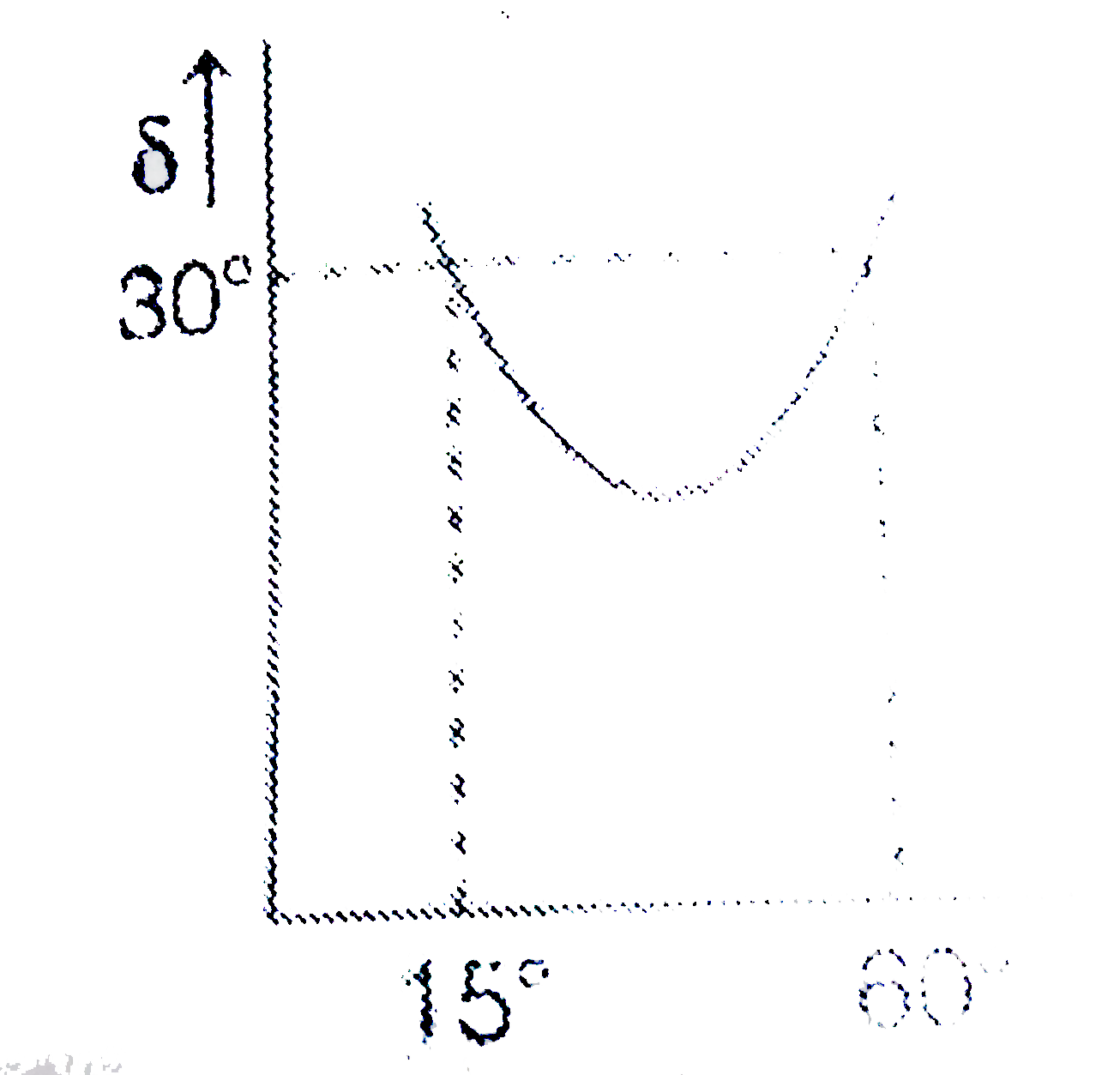STATEMENT - 1 Deviation produced by prism for yellow light is more that for red light.
STATEMENT - 2 : Angle of deviation δ varies with the angle of incidence.
STATEMENT - 3 : At angle of minimum the ray passes symmetrically through the prism, i.e., the angle of emergence of the ray from the second face is equal to the angle of incidence of the ray on the first face.
T T T
T T F
F T F
F F T
The correct Answer is:A
To analyze the statements provided in the question, we will evaluate each statement step-by-step.
Step 1: Evaluate Statement 1
Statement 1: Deviation produced by prism for yellow light is more than for red light.
1. Understanding Deviation: The angle of deviation (Δ) produced by a prism can be expressed as:
Δ=A(μ−1)
where A is the angle of the prism and μ is the refractive index of the light passing through the prism.
2. Refractive Index Relation: The refractive index (μ) is inversely proportional to the square of the wavelength (λ) of the light:
μ∝1λ2
3. Comparison of Wavelengths: Yellow light has a longer wavelength than red light. Therefore, since λy<λr, it follows that:
μy>μr
4. Conclusion for Statement 1: Since the refractive index for yellow light is greater than that for red light, the deviation for yellow light will be greater than for red light:
Δy>Δr
Thus, Statement 1 is true.
Step 2: Evaluate Statement 2
Statement 2: Angle of deviation Δ varies with the angle of incidence.
1. Understanding the Relationship: The angle of deviation can also be expressed in terms of the angle of incidence (I) and the angle of emergence (E):
Δ=I+E−A
2. Dependence on Angle of Incidence: As the angle of incidence changes, the angle of emergence also changes, which means that the angle of deviation will vary accordingly.
3. Conclusion for Statement 2: Therefore, Statement 2 is true.
Step 3: Evaluate Statement 3
Statement 3: At angle of minimum deviation, the ray passes symmetrically through the prism.
1. Understanding Minimum Deviation: At minimum deviation (Δm), the incident ray and the emergent ray are symmetric with respect to the prism. This means:
I=E
2. Relation at Minimum Deviation: At minimum deviation, the angle of incidence equals the angle of emergence, and the ray travels parallel to the base of the prism.
3. Conclusion for Statement 3: Therefore, Statement 3 is true.
Final Conclusion
All three statements are true. Hence, the correct option is True, True, True.
---
Statement 1: Deviation produced by prism for yellow light is more than for red light.
Δ=A(μ−1)
where A is the angle of the prism and μ is the refractive index of the light passing through the prism.
μ∝1λ2
μy>μr
Δy>Δr
Thus, Statement 1 is true.
Statement 2: Angle of deviation Δ varies with the angle of incidence.
Δ=I+E−A
Statement 3: At angle of minimum deviation, the ray passes symmetrically through the prism.
I=E
All three statements are true. Hence, the correct option is True, True, True.
Topper's Solved these Questions
- RAY OPTICS AND OPTICAL INSTRUMENTSBOOK - AAKASH INSTITUTE ENGLISHCHAPTER - RAY OPTICS AND OPTICAL INSTRUMENTSEXERCISE - Assignment (Section - I) Subjective Type Questions
6 Videos
- RAY OPTICS AND OPTICAL INSTRUMENTSBOOK - AAKASH INSTITUTE ENGLISHCHAPTER - RAY OPTICS AND OPTICAL INSTRUMENTSEXERCISE - Assignment (Section - J) Aakash Challengers Questions
7 Videos
- RAY OPTICS AND OPTICAL INSTRUMENTSBOOK - AAKASH INSTITUTE ENGLISHCHAPTER - RAY OPTICS AND OPTICAL INSTRUMENTSEXERCISE - Assignment (Section - G) Integer Answer Type Questions
3 Videos
- PHYSICAL WORLDBOOK - AAKASH INSTITUTE ENGLISHCHAPTER - PHYSICAL WORLDEXERCISE - ASSIGNMENT (Section-B)
4 Videos
- SEMICONDUCTOR ELECTRONICS (MATERIAL, DEVICES AND SIMPLE CIRUITS )BOOK - AAKASH INSTITUTE ENGLISHCHAPTER - SEMICONDUCTOR ELECTRONICS (MATERIAL, DEVICES AND SIMPLE CIRUITS )EXERCISE - Assignment SECTION - D (Assertion & reason type Question)
10 Videos
Similar Questions
A ray of light passes through the equilateral prism such that angle of incidence is equal to the angle of emergence if the angle of incidence is 45∘. The angle of deviation will be
View SolutionA ray passes through a prism of angle 60∘ in minimum deviation position and suffers a deviation of 30∘. What is the angle of incidence on the prism
View SolutionFigure shows graph of deviation δ versus angle of incidence for a light ray striking a prism. Angle of prism is

View SolutionDraw a ray diagram to show the refraction of a monochromatic ray through a prism when it suffers minimum deviation. How is the angle of emergence related to the angle of incidence in the position.
View SolutionThe angle between the incident ray and the refracted ray of a prism is called angle of deviation.
View SolutionA light ray of angles of incidence 40∘ emerged from the prism in minimum deviation position. Then what is the angle of incidence on the second surface ?
View SolutionIf a light ray incidents normally on one of the faces of the prism of refractive index 2 and the emergent ray just grazes the second face of the prism, then the angle of deviation is
View SolutionIf a light ray incidents normally on one of the faces of the prism of refractive index 2 and the emergent ray just grazes the second face of the prism, then the angle of deviation is
View SolutionA ray of light incident at an angle of incidence 'I' passes through an equilateral glass prism such that the refracted ray inside the prism is parallel to its base and emerges from the prism at an angle of emergence 'e'.
How is the angle of emergence 'e' related to the angle of incidence 'i' ?
View SolutionA ray of light is incident normally on one of the faces of a prism of apex angle 30 degree and refractive index √2. The angle of deviation of the ray in degrees is
View Solution
